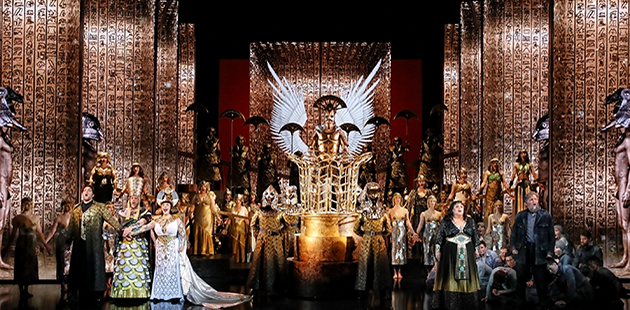 If you only go along to a performance of Aida for the Triumphal March, be forewarned. This production doesn’t have a Triumphal Procession. Instead, during the music Verdi wrote for the triumphant return of the Egyptian army in which it displays its victory spoils, the audience is treated to film of a masked horseman galloping through a valley of sand hills.
If you only go along to a performance of Aida for the Triumphal March, be forewarned. This production doesn’t have a Triumphal Procession. Instead, during the music Verdi wrote for the triumphant return of the Egyptian army in which it displays its victory spoils, the audience is treated to film of a masked horseman galloping through a valley of sand hills.
But despite this omission, this staging of Verdi’s epic of love story about an Ethiopian handmaiden and an Egyptian princess, who both fall in love with the same Egyptian General, is never less than diverting and often visually and aurally dazzling.
This ground-breaking, digital production of Aida, touted as the future of stage spectacle in opera, contains plenty of sensational elements to qualify it for your “must see” list. Replacing conventional scenery are multiple high-tech movable LED screens and ‘ghost’ gauzes, onto which images are projected in extraordinary high definition, to create sensational visual images.
Golden serpents slither sensuously up giant pillars in the great crowd-filled halls. A huge black panther, representing the inner thoughts of Amneris, glowers over her shoulder while she interrogates Aida. Beautiful cloud and water effects dissolve into each other.
There are also moments when the choice of visuals is puzzling and you find yourself distracted, wondering why, as he sings Celeste Aida, Radames is dreaming of a beautiful black Ethiopian woman who bears absolutely no resemblance to the Aida on stage.
Why do those huge muscular near-naked gods keep moving in and out of the great hall endlessly saluting out-of-time to the music? Why are there whirling dervishes in ancient Egypt? What are those shirtless storm troopers doing at an Egyptian orgy? Why is Aida trying to persuade Radames to escape the heat of the desert sun and run away with her when they are both clearly standing on a cool, moonlit beach?
It quickly becomes clear that director, Davide Livermore is more interested in the visual than the dramatic elements of the story, for despite the ambiguousness of many of the visual elements of his production, his staging is remarkably conventional and static.
There’s practically no physical contact, or chemistry, between any of the protagonists. For most of the opera they simply sit or stand and sing to the front, barely noting the presence of the other, and relying on old-fashioned stock gestures to denote emotion.
The Opera Australia chorus, resplendent in Gianluca Falaschi’s extraordinarily lavish costumes, is contained in tightly regimented groups, which works to its advantage when the mighty orchestra, under the baton of Andrea Battistoni, strikes up the massive choruses. A large troupe of dancers provides the movement, which despite their best efforts at decadence, is mostly ungainly and surprisingly tedious.
In many ways this static direction serves the production well, because opera is about the singing and Livermore has been gifted with three outstanding principal singers, each of whom rises to the occasion magnificently to hold their own against the lavishness of the staging.
American soprano, Amber Wagner, making her role debut as Aida, is simply sensational, with a huge voice capable of sailing effortlessly above the combined forces of the huge chorus and orchestra for Verdi’s magnificent massed choruses, and heart-breakingly tender for her beautiful rendering of her first act solo Ritorna Vincitor (Return a conqueror), which elicited an excited audience response.
She had a worthy adversary in Russian born contralto, Elena Gabouri, as Amneris, who displayed her arresting lower register to great effect, firstly raging at Aida when she admitted her love of Radames, then more tenderly in the final moments, high above the stage, reflecting on the fate of the doomed lovers.
Handsome Italian tenor, Riccardo Massi, was perfectly cast as the object of both women’s affections, Radames, whose opening solo, Celeste Aida (Heavenly Aida) set a high bar which was maintained by the rest of the topline cast, among them Warwick Fyfe as Amonasro, the king of Ethiopia, Jud Arthur as the King of Egypt, Roberto Scandiuzzi as the High Priest, Ramfis, Jane Ede as the High Priestess, and Dean Bassett as the Messenger.
Opera Australia has announced plans for three more digital productions next year. It will be interesting to see how this new technology adapts to the requirements of each of those operas. Meanwhile, this production of Aida provides a tantalizing preview of how we may view opera in the future.
Aida
Joan Sutherland Theatre – Sydney Opera House, Bennelong Point
Performance: Wednesday 18 July 2018 – 7.30pm
Season continues to 31 August 2018
Information and Bookings: www.opera.org.au
Image: Riccardo Massi as Radamès, Roberto Scandiuzzi as Ramfis, Elena Gabouri as Amneris, Jud Arthur as The King, Amber Wagner as Aida, Warwick Fyfe as Amonasro, the Opera Australia Chorus, Actors and Dancers in Opera Australia’s 2018 production of Aida at the Sydney Opera House – photo by Prudence Upton
Review: Bill Stephens OAM
